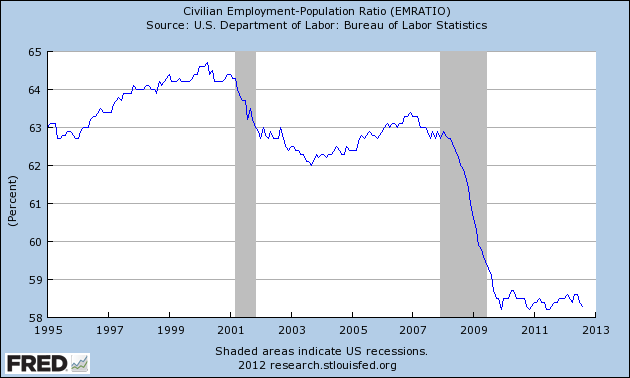 |
This is a file from the Wikimedia Commons. Information from its description page there is shown below.
Commons is a freely licensed media file repository. You can help.
|
Understanding the chart
The EMRATIO is computed as the "Civilian employment" divided by "Civilian non-institutional population." In September 2012, these were (in thousands) 142,974 and 243,772 respectively, resulting in a ratio of 58.7%.
- Civilian employment (FRED Data series CE 160V): Includes those employed 16+ years of age but excludes those unemployed or outside the workforce.
- Civilian non-institutional population (FRED Data series CNP 160V): Civilian noninstitutional population is defined as persons 16 years of age and older residing in the 50 states and the District of Columbia, who are not inmates of institutions (e.g., penal and mental facilities, homes for the aged), and who are not on active duty in the Armed Forces.
The total U.S. population was approximately 315 million during 2012.
Summary
| DescriptionUS employment 1995-2012.png |
English: U.S. employment-population ratio, 1995-2012
|
| Date |
8 September 2012, 18:57:01 |
| Source |
http://research.stlouisfed.org/fred2/graph/?id=EMRATIO |
| Author |
Federal Reserve Bank of St. Louis |
Licensing
| Public domainPublic domainfalsefalse |
 |
This work is in the public domain in the United States because it is a work prepared by an officer or employee of the United States Government as part of that person’s official duties under the terms of Title 17, Chapter 1, Section 105 of the US Code. See Copyright. Note: This only applies to original works of the Federal Government and not to the work of any individual U.S. state, territory, commonwealth, county, municipality, or any other subdivision. This template also does not apply to postage stamp designs published by the United States Postal Service since 1978. (See 206.02(b) of Compendium II: Copyright Office Practices). It also does not apply to certain US coins; see The US Mint Terms of Use.
|
|
|
This file has been identified as being free of known restrictions under copyright law, including all related and neighboring rights.
|
File usage
The following pages on Schools Wikipedia link to this image (list may be incomplete):
SOS Children's Villages has brought Wikipedia to the classroom. SOS Children's Villages is famous for the love and shelter it brings to lone children, but we also support families in the areas around our Children's Villages, helping those who need us the most. There are many ways to help with SOS Childrens Villages.




